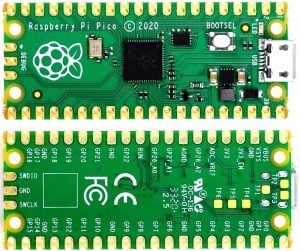A New 2” Mini Raspberry Pi Pico Launched
The Raspberry Pi Pico has the form factor of a Raspberry Pi Zero, but the functionality is much larger than that of the Raspberry Pi Zero.

Earlier today, the Raspberry Pi Foundation launched a new Single Board Computer (SBC) “PICO”. As the name suggests PICO, it is the smallest Raspberry Pi Board till date. This board has the form factor of a Raspberry Pi Zero, but the functionality is much larger than that of the Raspberry Pi Zero and at a fraction of the cost of the latter.
Raspberry Pi Pico is priced at a meagre $3, roughly around Rs. 350, is also their cheapest board yet. The $3 price tag is just for the board and no official Raspberry Pi accessories are given with it.
The new Raspberry Pi Pico is just 51mm long, 21mm wide and 1mm thick. With these dimensions Pico may set the trend of increasing the functionality of the board, at the same time, reducing the physical size of the board.
Coming to what is actually Raspberry Pi Pico, this tiny single board computer is a microcontroller board equipped with a Raspberry Pi’s own RP2040 chipset. The RP2040 is a low-cost high-performance dual-core ARM Cortex M0+ processor-based MCU.
The RP2040 is supported with both C, C ++ and micro-python, meaning that if you're a beginner and want to learn any of these languages, the Raspberry Pi Pico would be the best product-option to start with.
To this date, you might have used Raspberry Pi as an accessible, portable computer and worked on many projects. Now, using this RP2040 microcontroller, you will be able to make new and interesting projects.
Specifications of Pico:
- RP2040 microcontroller chip designed by Raspberry Pi.
- Dual-core ARM Cortex M0+ processor, flexible clock running up to 133 MHz
- 264KB of SRAM, and 2MB of on-board Flash memory
- Castellated module allows soldering direct to carrier boards
- USB 1.1 Host and Device support
- Low-power sleep and dormant modes
- Drag & drop programming using mass storage over USB
- 26 × multi-function GPIO pins
- 2 × SPI, 2 × I2C, 2 × UART, 3 × 12-bit ADC, 16 × controllable PWM channels
- Accurate clock and timer on-chip
- Temperature sensor
- Accelerated floating point libraries on-chip
- 8 × Programmable I/O (PIO) state machines for custom peripheral support
What is different in Pico, is that unlike the Raspberry Pi Zero, the Pico is less for DIY Projects and more for learning different programming languages like C, C++ and Python. The drag and drop feature makes it ideal for kids to start programming.
More information can be found on the product page here.







